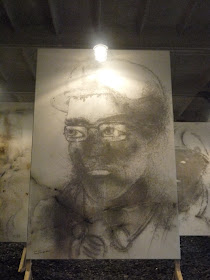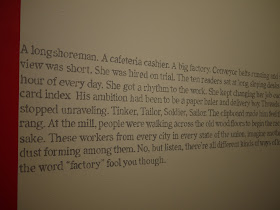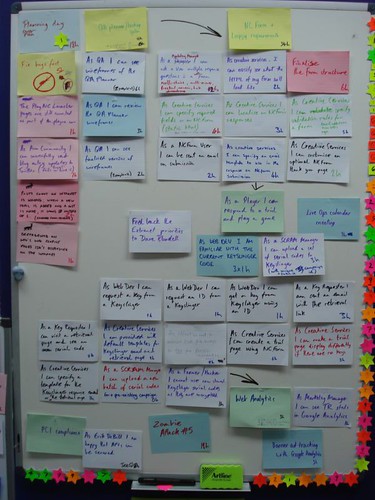Often when conversations about new museum initiatives come
up, the reason for inaction is
that there’s too much to do and not enough funding. I won’t argue with the fact that right now is a really
stressful financial time for every organization, but I do want to propose that
perhaps, local history museums own too many meaningless objects--and that paying attention to meaningful objects will give us more time, more money, and more connections to our community. After all, consider the BBC/British Museum collaborative project, A History of the World in 100 Objects, a connection my colleague Christopher Clarke made at the WNYAHA meeting last month at the same time I was working my way through the BBC audio.
A couple months ago, I was working on a planning report for
a museum looking to be more targeted about their contemporary collecting
efforts. A tweet looking for other
models sent me to the McLean County (Illinois) County Historical Society and
Susan Hartzhold, their curator, was good enough to chat with me about their
efforts.
This historical society is an old one, founded in 1892, and
a relatively large one, with 9
full-time staffers. When
collecting started, in 1892, all
the objects were collected with provenance—a way of enhancing and reinforcing a
sort of ancestor worship, I suspect. Susan’s been on staff for 20 years and she describes the
issue as “stuff vs. meaningful stuff.”
As an organization, they were facing decades of collecting from curators
who, for whatever reason, didn’t ask the questions that would provide the
context for the object.
Some historical societies and museums might just shrug their
collective shoulders at that issue—but McLean County chose another
direction. For the last ten years,
the staff has gone back and looked at every single object, trying to find, through research, what meanings there are for each object—who
owned, who used it, how it
compares to others. They
have looked at 18000 objects and deaccessioned 6000 of them.
There was not a collecting policy until the 1970s and now,
Susan says, they have become, as a staff, hard-nosed about the collections they
hold. They have gotten rid of
things that qualify as a “cabinet of curiousities,” had no provenance or were in poor condition. They have established benchmarks (i.e.
limitations on the number of something—like wedding dresses from the same
period) and objects with provenance always trump objects with no provenance.
It’s taken ten years and is part of a larger strategic plan—but
what’s equally important, the size of the collection still stands at 18,000
because the society has continued to collect, but have been much more focused
and strategic in their collecting.
What is that new collecting like?
Much of it has happened through partnerships with community
organizations. A local Black
History Project grew from a teachers’ project and the museum became a
repository for materials that were collected documenting the African American
community in the county.
There is an active South Asian community and the museum
worked for five years to more fully engage with them—a task that was helped
substantially by bringing in a traveling exhibit on Asian Games and inviting
groups to support the exhibit. But
the engagement didn’t end with the traveling exhibit, the museum continues to
work with the South Asian community.
There is a growing Hispanic community in the county and the
museum has begun efforts to engage with it. Susan admits that it’s a challenging effort as the museum is
located in a courthouse, which makes many new immigrants fearful. They are
currently working towards a partnership with a community’s Hispanic group to
develop programming for an upcoming exhibit about traditional Mexican
arts.
Susan makes the point that these community efforts take a
long time, take patience.
She says, “We have to go to them, we have to say, what can we do for
you?’
And that’s a great take-away from this story. Collecting and caring for collections
is a time-consuming process—but a wasted one unless we really approach the
process in a thoughtful way—both in terms of what we have and in terms of how
we engage with our communities today.
Images and captions courtesy of the McLean County Historical Society, and many thanks to Susan for taking time to share her work.
Top:
The nightgown was
donated by a local woman, Jean, who was born in 1916. When asked about
the nightgown, Jean had a wonderful story -- She said that she was surprised by
the gift, that it really wasn't her style. She felt that her husband had
purchased it for one of two reasons:
1) He didn't know
what to get her, so he let a sales clerk in the lingerie department at the
local department store "convince him that it was exactly what she
wanted." During that time period lingerie departments always had
female sales clerks who helped both male and female customers. It wasn't
unusual for clerks to help male customers pick out gifts for their wives or
girlfriends.
2) "He'd seen
way too many Jean Harlow movies"
Jean said she only
wore the nightgown once, but the story and the nightgown tells us so much
about the culture of the time period.
Bottom:
The pottery was
brought to America by the Alvarez's family; purchased in Zacatecas,
Mexico. The donor’s father came to Bloomington in 1972, her mother and 2 brothers
followed in 1974. She joined them in 1975. Her parents returned to
Mexico in 1995, but the rest of the family stayed.










































